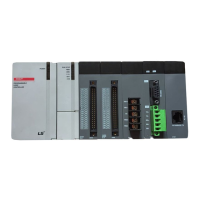Chapter 6 Motion Function Blocks
(11) The cam profile generated in the LS_CrossSealCamGen function is similar to the cam profile generated in the
LS_RotaryCutCamGen. For the RampIn profile, the operation starts when the main axis is at 270 and not at 0. The profile
also starts to perform sealing when the main axis is at 180 degrees.
(12) The sRampIn and sRampOut types generate a shortened cam profile of RampIn and RampOut respectively. When
operating using sRampIn and sRampOut, the cam operation starts when the main axis is at 0.
0
360
0
180
360
sRampIn
sRampOut
MasterAxis
SlaveAxis
270
180
(13) On the SealSpdRatio input, set the speed ratio for the sealing region. If SealSpdRatio is set to 100, a cam profile is
generated which operates by synchronizing 1:1 with the speed of the main axis in the sealing section. The higher the
SealSpdRatio value, the faster the synchronization speed in the cutting region. The setting range of SealSpdRatio is 50-200
and a "0x1174" error occurs if there is an error in the SealSpdRatio value.
(14) On the CamCurve, enter the curve of the cam profile to generate. If you enter 0:Linear, a cam profile is generated using
linear interpolation. Once you select linear interpolation, you must specify the number of cam profile points to generate by
setting CamPointNum. Take care when setting the number of points as too little can lead to a shock due to the acceleration
or deceleration of cam operation and too many can lead to an overload in the program due to the amount of computing
resources for saving cam profiles. If you enter 1:Cubic, a cam profile is generated that uses cubic interpolation. A "0x1176"
error occurs if the CamCurve value is outside of the range.
(15) The minimum number of cam points required for CamPointNum is 10 and a "0x1177" error occurs if there is an error in the
CamPointNum value.
(16) This motion function block is supported in the following versions:
Category
Module O/S XG5000

